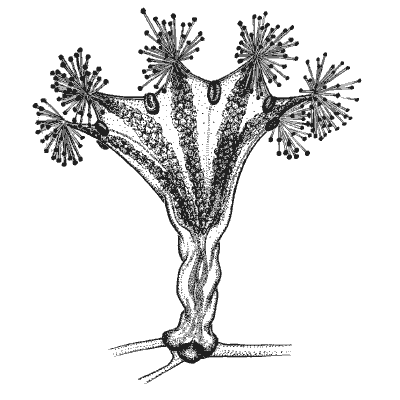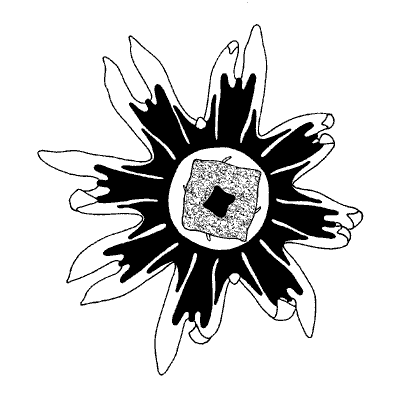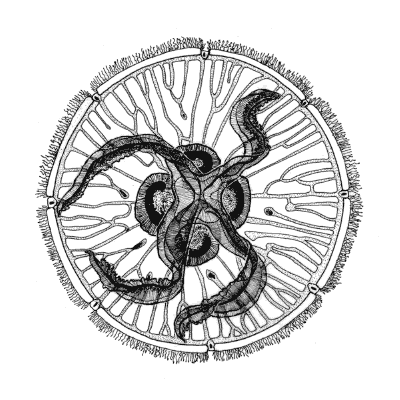 |
 |
|
 |
 |
 |
 |
 |
|
 |
 |
 |
 |

|
| |
PHYLUM CNIDARIA: CLASS SCYPHOZOA
Dale R. Calder
 The class Scyphozoa comprises the familiar jellyfishes, of major ecological significance in the plankton. Some, including the sessile stauromedusae and the polyp stages of metagenetic free-swimming medusae, occur as part of the benthos. Representatives of the group are found in all oceans and range bathymetrically from sea surface to abyss. All are marine. Of about 175 species recognized worldwide, six occurring in the Woods Hole area are considered here. The class Scyphozoa comprises the familiar jellyfishes, of major ecological significance in the plankton. Some, including the sessile stauromedusae and the polyp stages of metagenetic free-swimming medusae, occur as part of the benthos. Representatives of the group are found in all oceans and range bathymetrically from sea surface to abyss. All are marine. Of about 175 species recognized worldwide, six occurring in the Woods Hole area are considered here.
Scyphozoans share a number of attributes with other cnidarians: (1) they typically possess tentacles, (2) their symmetry is radial, (3) the body wall consists of an outer epidermis and inner gastrodermis, separated by a layer of jelly-like mesoglea, (4) the mouth is the only opening to the digestive system, (5) nematocysts or "stinging capsules", formed by specialized cells called nematocytes, are present. The medusae of Scyphozoa are unique in being typically much larger and anatomically more developed than the polyp. Moreover, they are acraspedote, i.e., they lack a velum (a shelf of tissue projecting inward from the margin of the bell in hydromedusae and cubomedusae).
Jellyfishes undergo a complex life cycle. Medusae of most species are dioecious, with the fertilized egg developing into a tiny (<1 mm), ciliated, free-swimming larva (planula). The planktonic, cigar-shaped planulae typically settle to the bottom after several hours or days and develop into tentacle-bearing polyps (scyphistomae). The sessile scyphistoma, reaching a few millimeters in height, may reproduce asexually, generally by budding or by formation of cysts (podocysts). Under suitable environmental conditions, scyphistomae undergo transverse segmentation and segment metamorphosis (strobilation). The segmented parts of the strobilating polyp (strobila) develop into incipient medusae that eventually break loose and become free swimming young jellyfishes (ephyrae). The ephyra grows rapidly into an adult medusa, completing the life cycle. Meanwhile, the basal part of the strobila reverts to a scyphistoma. After a period of growth this scyphistoma may reproduce asexually, or strobilate again, or both. While the medusa stages of scyphozoans are usually seasonal in occurrence, especially in temperate regions, their scyphistomae may be active all year. Under adverse conditions, the benthic stages may survive as dormant podocysts. Many species of jellyfishes, having sessile stages in their life cycles, are neritic in distribution. Exceptions occur as with the oceanic jelly (Pelagia noctiluca), a normal inhabitant of the open ocean. In that species, the planula develops directly into an ephyra and no bottom-dwelling scyphistoma stage exists.
Four orders are currently recognized in the Scyphozoa. The Stauromedusae are small, goblet-shaped, sessile scyphozoans that adhere to algae, rocks, shells, and other hard substrates, usually by a peduncle. Their life cycle involves an alternation between a polyp-like adult and a benthic planula larva; no free-swimming medusa stage is present. Most species inhabit cold waters. The Coronatae are marked by a distinctive groove around the umbrella of the medusa. Many coronates are heavily pigmented inhabitants of deep water. Their scyphistomae resemble hydroids and are protected by a chitinous tube. Coronates are unlikely to be encountered in the immediate vicinity of Woods Hole, although species such as Atolla wyvillei and Periphylla periphylla occur well offshore at bathyal depths. The three most conspicuous scyphozoans of the Woods Hole area (Aurelia aurita, Chrysaora quinquecirrha, Cyanea capillata) are assigned to the Semaeostomeae. These species have tentacles along or beneath the margin of the umbrella, long, frilly oral arms hanging down from the mouth. A coronal groove on the exumbrella, as in Coronatae, is lacking. The Rhizostomeae have no marginal tentacles, and their oral arms are fused and bear numerous small mouth openings. Two temperate-water rhizostome species (Rhopilema verrillii, Stomolophus meleagris) have been reported as far north as Long Island Sound in the western North Atlantic but not the Woods Hole region. Many texts still combine the box jellies and their relatives (Cubomedusae) as an order within the Scyphozoa. However, most specialists in the Cnidaria now recognize the Cubozoa as a distinct class (Cubozoa) because of their unique life cycles, morphology, and nematocyst complement.
Some species of scyphozoan jellyfishes are notorious for their sting. Three of those listed below (Chrysaora quinquecirrha, Pelagia noctiluca, and Cyanea capillata) are venomous to humans, and caution is warranted in handling any jellyfish.
For identification of ephyrae, consult Russell (1970, p. 24) and Larson (1976, p. 9). Scyphistomae of the various species below are extremely difficult to distinguish, although their nematocyst complement is of some utility in identification (see Calder, 1983, p. 1189).
The salinity regimes under which the various species of Scyphozoa normally occur in the region is indicated in the check list below using zones established under the "Venice System" (Symposium on the Classification of Brackish Waters, 1958).
Text Keys to Scyphozoa of the Woods Hole Region | Go To Visual Key
| 1. |
Planktonic Scyphozoa; medusoid in form; velum lacking |
2 |
| Benthic Scyphozoa; medusoid or polypoid in form |
5 |
| 2. |
Tentacles on subumbrella, in eight U-shaped groups |
Cyanea capillata |
| Tentacles restricted to umbrella margin |
3 |
| 3. |
Umbrella flat, plate-shaped; tentacles short, numerous; gonads four, horseshoe-shaped |
Aurelia aurita |
| Umbrella saucer-shaped to hemispherical; tentacles long |
4 |
| 4. |
Umbrella lacking prominent warts, flatter than a hemisphere; margin with eight groups of 3-5 tentacles |
Chrysaora quinquecirrha |
| Umbrella with prominent warts, hemispherical; margin with eight solitary tentacles |
Pelagia noctiluca |
| 5. |
Body medusoid but attached; distal end with eight arms; tentacles usually present on each arm (STAUROMEDUSAE) |
6 |
| Body polypoid, small (1-3 mm); tenatacles in a single, distal whorl |
scyphistoma stage |
| 6. |
Adhesive organs (anchors) present between arms; anchors kidney-shaped; gonads extending into arms (Fig. 1) |
Haliclystus auricula |
| Adhesive organs (anchors) lacking; arms short; peduncle short |
Craterolophus convolvulus |
Check List of Scyphozoans of the Woods Hole Region
Phylum Cnidaria, Class Scyphozoa
Order Stauromedusae, Suborder Eleutherocarpida
Family LUCERNARIIDAE 
[^] Haliclystus auricula (Rathke, 1806). Polyhaline--euhaline. Nobska Point, on Fucus; absent during the summer (Smith, 1964); Woods Hole, most common on Scytosiphon (Larson, 1976).
Fig. 1. Haliclystus auricula (modified from a photograph by D. P. Wilson).
Suborder Cleistocarpida
Family DEPASTRIDAE 
[^] Craterolophus convolvulus (Johnston, 1835). Polyhaline--euhaline. Nobska Point, on Fucus; absent during the summer (Smith, 1964).
Fig. 2. Craterolophus convolvulus
Order Semaeostomeae
Family PELAGIIDAE 
[^] Chrysaora quinquecirrha (Desor, 1848). The "sea nettle". Oligohaline--euhaline. Common to abundant during summer, especially in estuarine waters. Venomous.
Fig. 3. Chrysaora quinquecirrha, medusa (from a photograph by R. J. Larson).
Fig. 4. Chrysaora quinquecirrha, ephyra stage.


[^] Pelagia noctiluca (Forsskål, 1775). The "oceanic jelly". Euhaline. An oceanic species infrequently carried inshore in gyres of the Gulf Stream. Venomous.
Fig. 5. Pelagia noctiluca, medusa.

Family CYANEIDAE 
[^] Cyanea capillata (Linnaeus, 1758) [Cyanea arctica Péron and Lesueur, 1809; Cyanea fulva L. Agassiz, 1862]. The "lion's mane". Mesohaline--euhaline. Frequent throughout the area during winter and spring, and occasionally in summer. Two varieties occur locally, arguably representing different subspecies or even species. The boreal Cyanea capillata var. arctica seems to differ from the temperate C. capillata var. fulva in its larger maximum size, in color, in some minor morphological characters (e.g., in lacking exumbrellar papillae), and possibly in ecology including seasonality (see Brewer, 1991). Venomous.
Fig. 6. Cyanea capillata, medusa (modified from L. Agassiz, 1862).
Fig. 7. Cyanea capillata, ephyra stage.
Family ULMARIDAE 
[^] Aurelia aurita (Linnaeus, 1758) [Aurelia flavidula Péron and Lesueur, 1809]. The "moon jelly". Mesohaline--euhaline. Frequent throughout the area during late spring and summer. Seldom venomous to humans in the Woods Hole area.
Fig. 8. Aurelia aurita, medusa.
Fig. 9. Aurelia aurita, scyphistoma stage with bud (modified from L. Agassiz, 1862).
Fig. 10. Aurelia aurita, ephyra stage.
Acknowledgments
I thank Patrice Stephens-Bourgeault of the Royal Ontario Museum for the artwork accompanying this key. All illustrations are hers except for those of the ephyra stages.
Selected References on Scyphozoa
top | key | List | Citations
Arai, M. N. 1996. A Functional Biology of Scyphozoa. Chapman and Hall, London. 300 pp.
Brewer, R. H. 1991. Morphological differences between, and reproductive isolation of, two populations of the jellyfish Cyanea in Long Island Sound, USA. Hydrobiologia 216/217:471-477.
Cairns, S. D., et al. 1991. Common and scientific names of aquatic invertebrates from the United States and Canada. Cnidaria and Ctenophora. Am. Fish. Soc. Spec. Pub. 22. 75 pp.
Calder, D. R. 1983. Nematocysts of stages in the life cycle of Stomolophus meleagris, with keys to scyphistomae and ephyrae of some western Atlantic Scyphozoa. Can. J. Zool. 61:1185-1192.
Halstead, B. W. 1988. Poisonous and Venomous Marine Animals of the World. 2nd ed. Darwin Press, Princeton. 1168 pp.
Hargitt, C. W. 1904. The Medusae of the Woods Hole Region. Bull. U.S. Bur. Fish. 34:21-79.
Hirano, Y. M. 1997. A review of a supposedly circumboreal species of stauromedusa, Haliclystus auricula (Rathke, 1806). Proc. 6th Int. Conf. Coelenterate Biol., 1995. 247-252.
Kramp, P. L. 1961. Synopsis of the medusae of the world. J. Mar. Biol. Assoc. U.K. 40:1-469.
Larson, R. J. 1976. Marine flora and fauna of the northeastern United States. Cnidaria: Scyphozoa. NOAATech. Rep. NMFS Circ. 397. 18 pp.
Larson, R. J., C. E. Mills, and G. R. Harbison. 1991. Western Atlantic midwater hydrozoan and scyphozoan medusae: in situ studies using manned submersibles. Hydrobiologia 216/217:311-317.
Mayer, A. G. 1910. Medusae of the world. Vol. III. The Scyphomedusae. Carnegie Inst. Washington Publ. 109:499-735.
Russell, F. S. 1970. The Medusae of the British Isles. II. Pelagic Scyphozoa With a Supplement to the First Volume on Hydromedusae. Cambridge University Press, Cambridge. 284 pp.
Smith, R. I. (ed). 1964. Phylum Cnidaria, class Scyphozoa. Pp. 21-24 in Keys to Marine Invertebrates of the Woods Hole Region. Systematics-Ecology Program, Marine Biological Laboratory, Woods Hole, Massachusetts.
Symposium on the Classification of Brackish Waters. 1958. The Venice System for the classification of marine waters according to salinity. Oikos 9:311-312.
Verrill, A. E. 1874. Report upon the invertebrate animals of Vineyard Sound and adjacent waters, with an account of the physical features of the region. Rep. Comm.Fish. 1871-1872:295-747.
|
|
 |
 |
|